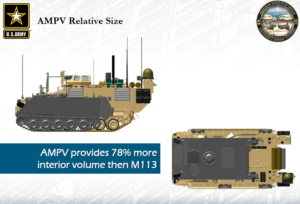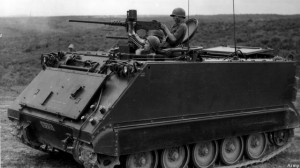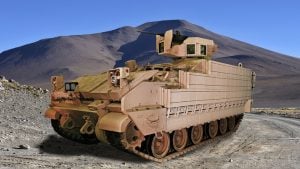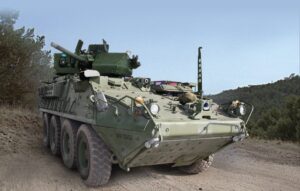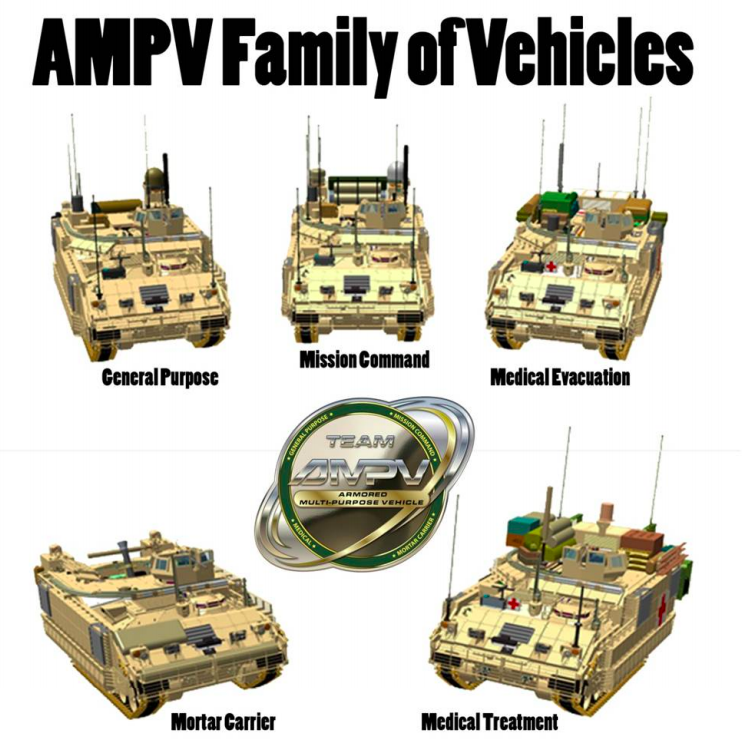BAE Gets $873M For AMPVs, Spelling The End of The ‘Aluminum Coffin’ M113
Posted on
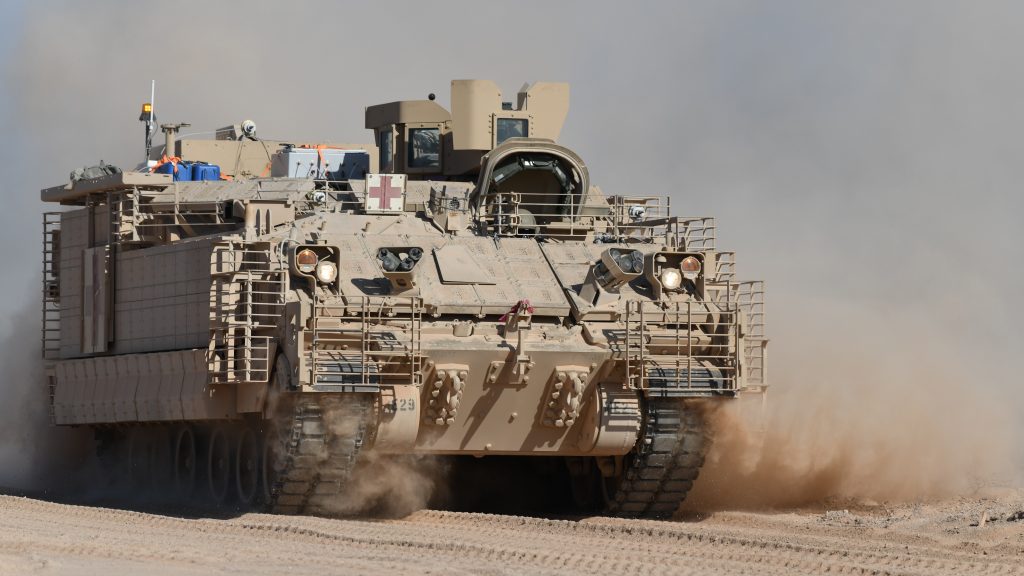
A medical variant of the BAE Armored Multi-Purpose Vehicle. AMPVs will serve as both armored ambulances and mobile operating rooms.
UPDATED with graphics, Full Rate Production Date WASHINGTON: After six decades in service, the US Army is finally phasing out its M113 Armored Personnel Carrier, under-armored even in Vietnam, while trying to buy a new, sturdier workhorse for modern warfare: the Armored Multi-Purpose Vehicle.
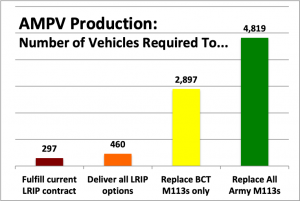
AMPV: Armored Multi-Purpose Vehicle. LRIP: Low Rate Initial Production. BCT: Brigade Combat Team. SOURCE: Army
The AMPV is basically the standard M2 Bradley, minus the gun turret removed, plus multiple automotive and protection upgrades. It’s thoroughly proven technology, not revolutionary, and there have been reports that the Army’s forthcoming 2020 budget will move some money out of AMPV to all-new Next Generation Combat Vehicles, some of which may be robotic.
On the current plan, sources tell us, BAE will begin building AMPVs next month under a $873 million contract for the first 297 machines. And that’s just part of what the Pentagon calls Low Rate Initial Production. The full LRIP phase, plus prototypes already built, could total about 460 vehicles for $1.2 billion. (That’s counting the ones in today’s announcement, which was for the exercise of two contract options totaling $575 million).
The Army wants Full Rate Production — scheduled to begin in fall 2021 (1QFY22) — to replace almost 3,000 M113 variants in service with its armored brigades, which would bear the brunt of any future ground wars. Yes, the “aluminum coffin,” as some crews called it, was long ago replaced in frontline infantry companies and scout troops by the better armed and armored Bradley. But many M113 variants remain in service just behind the forward companies as mobile command posts, armored ambulances, weapons carriers, and general-purpose workhorses.
In Iraq, those M113 variants were deemed too vulnerable to roadside bombs and either confined to base or not deployed at all. (Even in Vietnam the main threat was not guns but mines, leading many soldiers to feel safer riding on top of the M113 rather than inside). That worked as long as the Army could use an extensive network of bases and supply routes to support relatively static counterinsurgency operations. But in a fast-moving mechanized war in Eastern Europe, the armored brigades would need support vehicles that can both keep up with M1 tanks and Bradleys over rough terrain – hence the Army’s insistence on tracks, not wheels – and stand a chance against Russian firepower.
The Army’s not just brigades, however. Further behind the line, there are over 1,900 more M113 variants in service with division and corps-level support units. All of those will to be replaced by something as they wear out.
Those “echelons above brigade” will be essential supplying and coordinating a large-scale war. But since they don’t have to come right up to the front line like brigade support troops, they might make do with a wheeled vehicle. That could be a second shot for General Dynamics’ 8×8 Stryker, which BAE’s tracked offering beat out for the brigade-level AMPV.
None of this is to disparage the Stryker. It’s the mainstay of the Army’s medium weight brigades, which can do thousand-mile road marches across Eastern Europe with a speed and reliability that heavier, more maintenance-intensive and fuel-hungry tracked vehicles can’t match.
That’s why the Army is investing in Stryker upgrades, including more mine-resistant double-V-shaped hulls, upgunned models with new 30 mm cannon and Javelin anti-tank missiles, and an anti-aircraft variant. It might also buy a truck-mounted howitzer (not on a Stryker chassis) to upgun the Stryker brigades. Those brigades would play important roles against Russia: rapid response to incursions by lightly armed “little green men,” screening and delaying actions against an all-out armored invasion. But they’re still 20-30 ton wheeled vehicles (depending on the variant) that can’t take on 50-ton T-90 tanks.
The AMPV isn’t meant to fight main battle tanks either – most variants are only armed with a machinegun – but it will have to come right behind the firing line for at least some missions. The most urgent of those is as an armored ambulance, but all of the five AMPV variants will operate well in range of Russian artillery and at times in direct line of fire from tanks.
- Command & Control: a mobile, armored command post. Since at least the 1980s, Russian doctrine has called for fast-moving armored spearheads to penetrate Western lines and hunt down these critical targets. And with Russia ahead of the US in electronic warfare, command posts may have to move well forward just to communicate with frontline troops in the face of heavy jamming.
- Medical Evacuation: the armored ambulance, capable of carrying three medics and up to six seated patients (four in stretchers). Russia’s formidable anti-aircraft capabilities may keep medevac helicopters at bay, making the AMPV a wounded soldier’s best bet to survive.
- Medical Treatment: a mobile, armored operating room, with space for four medical specialists to perform surgery on a single patient. The closer this vehicle is to the front, the better the chance that wounded soldiers can get to surgical care within the “golden hour.”
- Mortar Carrier: the only AMPV variant armed with more than a machinegun. Mortars are the form of artillery closest to the front line. Less powerful and shorter-ranged than self-propelled howitzers like the M109 Paladin, they’re also generally closer at hand and more responsive. They’re also major targets.
- General Purpose: the all-purpose workhorse. Unlike the original M113, the AMPV isn’t intended to carry combat troops, but it might have to bring ammunition, repair parts, or even reinforcements right to the front in time of need. The GP machines might also have to evacuate casualties when the dedicated AMPV ambulances can’t keep up with the carnage of a major war.
While better armored by far than the old M113, the AMPV and its M2 Bradley elder brother still can’t shrug off anti-tank missiles. For that matter, even the massive M1 Abrams main battle tank is at risk, as Saudi losses against the Houthi rebels in Yemen have shown. Protection against this threat will require what’s called Active Protection Systems to jam, decoy, or shoot down incoming missiles – another major part of the Army’s rush to modernize.
Subscribe to our newsletter
Promotions, new products and sales. Directly to your inbox.

